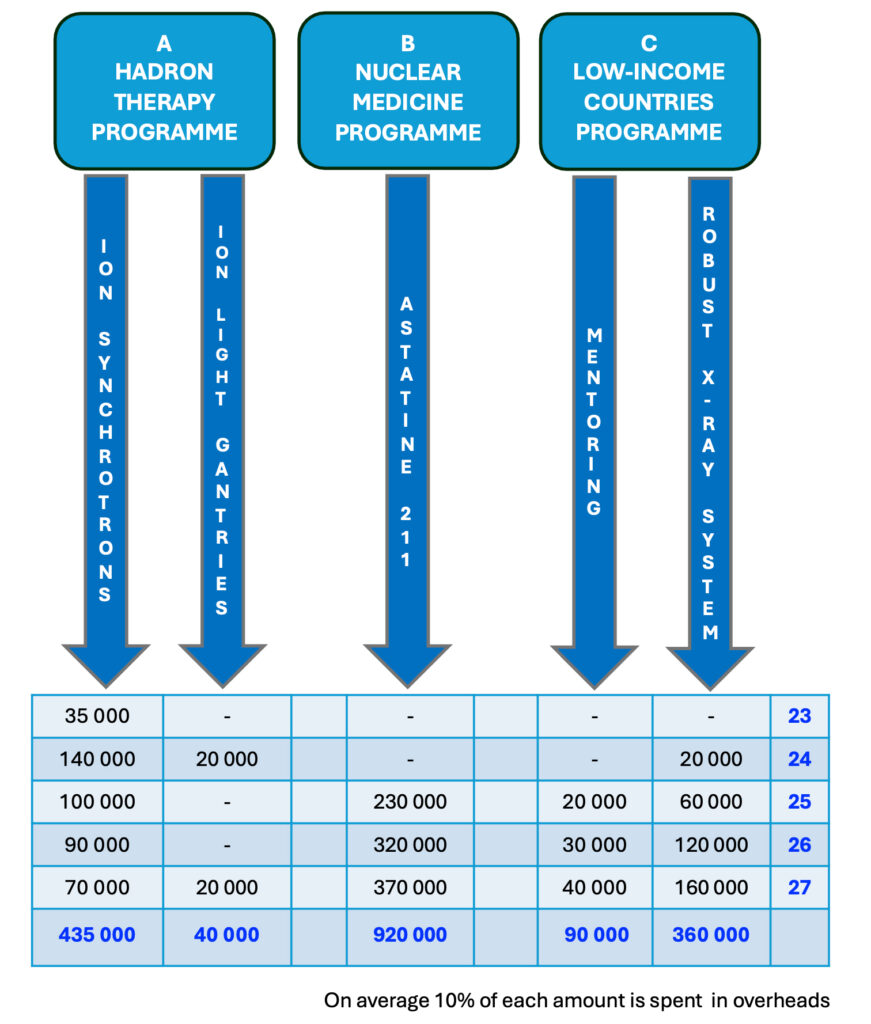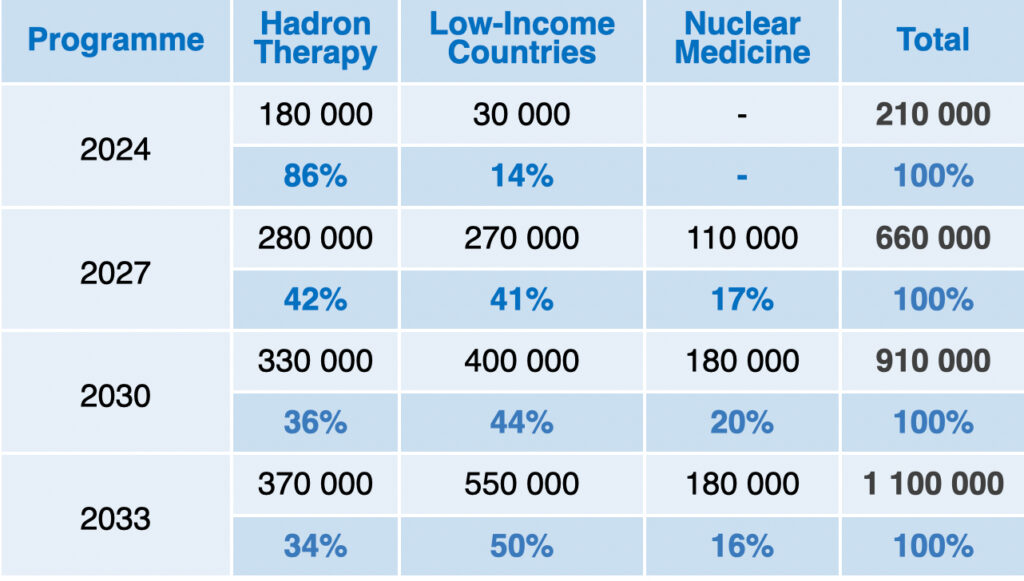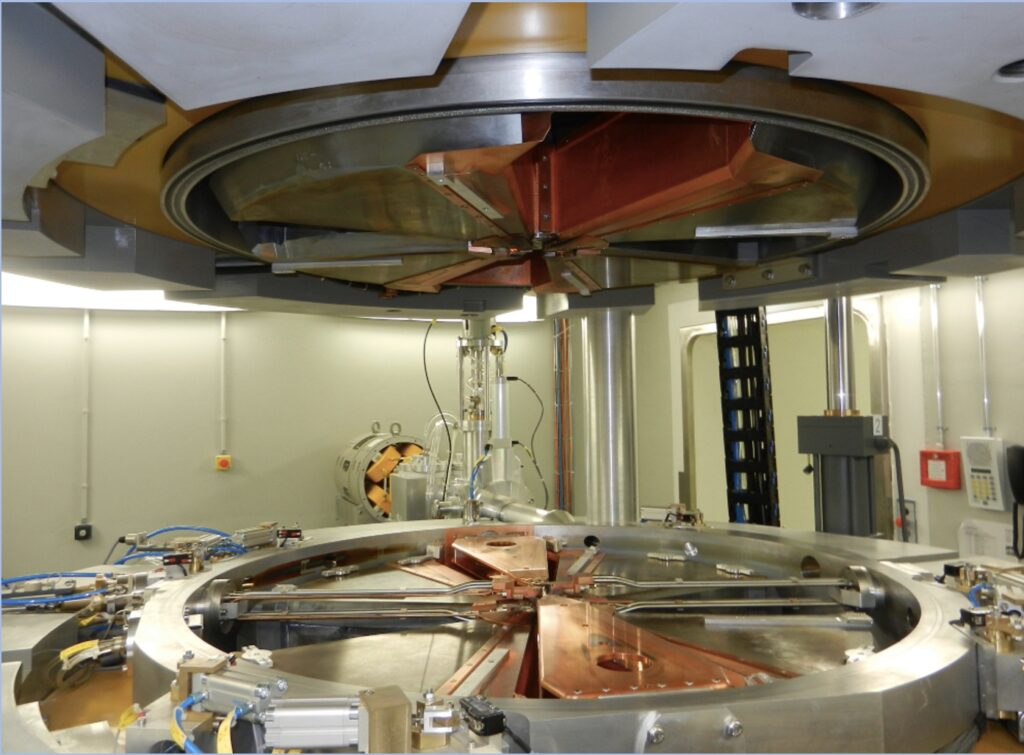
The Next Ions Medical Machine Study, initiated in 2018 by CERN, focuses on novel technologies for cancer therapy with ion beams. An important part of NIMMS is the design of two compact synchrotrons: the first for helium ions and the second, based on superconducting magnets of the last generations, for carbon ions. On behalf of the Collaboration, Technical Director Elena Benedetto leads these designs so that Tera-Care contribution is essential for NIMMS success.
EXPECTED OUTCOMES: Using the helium synchrotron of NIMMS, Tera-Care has proposed to design and build CHeFS, a Clinical Helium Facility for Switzerland. The linear accelerator (linac), which injects helium ions in the synchrotron, will be used to produce Astatine-211 (Project 3). The synchrotron will treat patients with high energy helium beams that can reach a depth of 30 centimetres in water. Its Technical Design Report will be available by the middle of 2025.
A gantry, rotating around the patient’s bed, can irradiate a tumour with beams coming from the directions that minimize the damages to normal tissues. The lightest gantry for carbon ions, built in Japan, weights 300 tons. TERA has proposed a novel superconducting design called SIGRUM. Its performances will be further improved using novel high-temperature superconducting magnets.
EXPECTED OUTCOMES: Tera-Care will reassess the initial design of SIGRUM, already improved in collaboration with CERN. The advantages are the weight (4-5 time less than the existing gantries) and the simplifications in transporting and mounting it. The final Report will be ready by the end of 2024. The project will be left in standby till the beginning of 2027 when the use of novel superconducting magnets will be resumed.
Theragnostics is a rapidly-growing clinical modality that combines diagnostic imaging (PET and SPECT) and therapy through the injection of the same molecule, labelled with one or two radioisotopes. Tera-Care, in collaboration with the University of Bern, aims at designing and prototyping the linac (linear accelerator) of CHeFS (Project 1) to produce Astatine-211, a very promising isotope in Targeted Alpha Therapy for the cure of disseminated tumours and micro-metastases.
EXPECTED OUTCOMES: The linac (linear accelerator), which injects helium in the Clinical Helium Facility for Switzerland (CHeFS), will accelerate a very intense beam of helium ions up to 29 MeV to produce Astatine-211. In the years 2025-2027 Tera-Care will contribute – with CERN and other partners – to the design of CHeFs-one (the the first stage CHeFS) and to the construction of the prototypes of its most important components.
In the years 2025-2027 Tera-Care will invest CHF230 000, CHF320 000 and CHF360 000 to contribute to the Technical Design Report of CHeFs-one, which in the present plan will be completed by the middle of 2027. If the CHeFS Consortium will be formed by the end of 2026 and construction money will be available, construction drawings could start at the beginning of 2027. With the schedule shown in the table, Astatine-211 production could start in 2032-2033.

By setting-up of collaborations with international organizations, Tera-Care aims at contributing to the training in LMICs of the much-needed radiation oncologists and technicians. Collaborations with AORTIC (African Organisation for Research and Training in Cancer) and with AROME (Association de Radiothérapie et d’Oncologie de la Méditerranée) have been initiated.
EXPECTED OUTCOMES: With the support of collaborating organizations, mentoring schemes and education programs will be strengthened in Low-Income Countries to train the local staff to become well-qualified radiation oncologists and technicians. They will then be in a stronger position to deploy the benefits of the (few) existing radiation therapy machines and of the (hopefully many) future robust X-ray radiotherapy units to be built by the STELLA collaboration presented in the next subsection.
Tera-Care is a member of the STELLA Project (Smart Technology to Extend Lives with Linear Accelerators: https://www.iceccancer.org/innovative-radiotherapy-technologies/) that has as main aim the design and the construction of a novelrobust X-ray linac system, which is conceived for the challenging conditions often found in LICs, requires less maintenance and is cost effective without compromising the quality of the radiation treatments.
EXPECTED OUTCOMES: Within the STELLA Project (an initiative of the International Cancer Expert Corps – ICEC) Tera-Care has the responsibility of designing the mechanical support which rotates around the patient bed. The active parts of the electron linac system attached to it will be easily accessible and replaceable. A first design will be ready by the end of 2025 and the Technical Design Report will be presented to the STELLA collaboration by the middle of 2026. The construction of a 1⁄2 scale prototype is foreseen.
In the medium term, the main Programme of Tera-Care will target Low- and Medium-Income Countries with the aim of saving lives by both mentoring and contributing to the design and, later, to the construction and installation in Africa of the STELLA robust X-ray system. The other half of the budget will be for therapy with hadron beams and novel theranostics for High-Income Countries.


View of the open cyclotron. In the back, the Beam Transfer Line (BTL), through which the proton beam is conveyed to the separate bunker used for research.